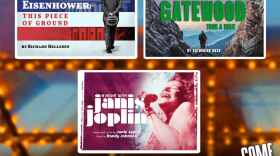The Sarasota Art Museum is situated on a busy expanse of U.S. 41 in central Sarasota in two historic buildings that were once part of the Sarasota school system.
Executive Director Virginia Shearer describes their restoration and transformation into one of Southwest Florida’s penultimate contemporary art museums.
“It’s called an adaptive re-use in architecture and design terminology, and that means that we’ve made as much use of the original material in the buildings – historic brick, historic wood,” said Shearer. “Then we’ve brought it up to date with contemporary features and created a kind of white cube gallery setting with wonderful skylights that can be transformed by the artists that we work with.”
Once inside, visitors find exhibitions of contemporary art ensconced on each of the main building’s three floors.

“Sarasota Art Museum is the region’s only teaching museum that is dedicated to contemporary art, or the art of our time,” Shearer noted. “Our focus is on working with living artists and art that is made in real time."
The museum has no permanent collection. Instead, it stages rotating exhibitions of transformative, relevant and pioneering artists in an ongoing effort to facilitate the appreciation and understanding of the art of our times.
While the art on display changes, the museum’s point of entry remains constant.
“You walk through our front doors, which used to be the back of Sarasota High School, and when you walk in, you’re immediately greeted by a beautiful, vibrant, colorful mural that’s all along the walls and up the stairwell that invites visitors to go and see what other art is in view,” Shearer said.

Rendered by San Francisco-based muralist Leah Rosenberg, “28 Colors of Sarasota” is reminiscent of a pack of Crayola crayons. However, each color symbolizes an iconic place within the city.
“Leah Rosenberg came to Sarasota,” Shearer recounted. “She walked around Sarasota. She spent a couple of months here in the lead-up to her project, and she defined a color scheme that is actually aligned to different places in Sarasota.”
Part of the fun of any visit to the Sarasota Art Museum is discovering the location to which each color corresponds … although the exhibitions on display are typically so compelling that many visitors pay only passing attention to the museum’s signature gateway artwork.

THE BACKGROUND:
During her interview, Virginia Shearer gave several examples of muralist Leah Rosenberg’s color scheme in “28 Colors of Sarasota.” “For example,” said Shearer, “the vibrant orange is for the Sarasota High School Sailors, which is part of Sarasota High School, and we are part of that.”
“The hot pink,” Shearer continued, “is Sarasota Art Museum’s color.”
“The verdant green corresponds with the Selby Gardens down the street,” Shearer pointed out. The other green, “nature green,” is the color of the palm fronds that line most Sarasota streets.
“There’s kind of a wonderful metal-like grey that corresponds with Michelangelo’s ‘David’ at the Ringling Museum,” said Shearer. The Ringling museum itself is represented in Rosenberg’s color palette by the color peach, and the other grey in the mural symbolizes “Snooty the Manatee,” a well-known statue in downtown Bradenton, “beloved by locals and tourists.”
“A little known color that often stumps people is a very bright yellow, and that yellow goes along with the Siesta Key lifeguard stand that is at the public beach,” Shearer said. “People often say, ‘Meet me at the blue’ or ‘Meet me at the yellow,’ and they mean a certain lifeguard stand.”
Rosenberg included an off-gray in the mural. According to the Sarasota Art Museum’s website, this color matches the risers on the stairs of the original high school building, so “it only makes sense for a stripe to match them.”
Violet is for the Van Wezel, which locals refer to as the “Purple Cow.”
Purple signifies Sarasota Lanes, “Sarasota’s own beloved bowling alley.”
Gold is for the Sarasota Opera House, an homage to the gold lettering on the famous building that was once visited by Elvis Presley.
The dark pinkish-purple represents the Burns Court Cinema, a favorite backdrop for local filmmakers and still photographers.
Navy blue stands for Sarasota’s iconic statue, “Unconditional Surrender.”
The other blue in the mural represents the Joseph’s Coat Skyspace, “a triumph of technology, engineering, and aesthetics … created by internationally renowned artist James Turrell, [which] is a gathering place for contemplation and offers a unique experience.”
Red is for the stripes on the tarps of the Ringling Bros. and Barnum & Bailey Circus.
Beige is the color of the sand at Siesta Key, reputed by some surveys to be the “best beach in the U.S.A.” That’s not to be confused with tan, which is the color that signifies the terracotta tile at Ca’ d’Zan, John and Mable Ringling’s waterside mansion.
Light green is for Spanish moss.
The mural’s mango color represents golden hour sunsets.
For more, visit https://www.sarasotaartmuseum.org/color-origins-from-the-28-colors-display/.








